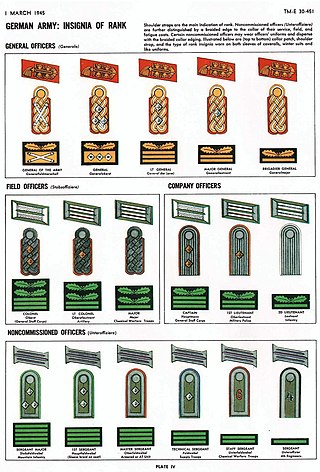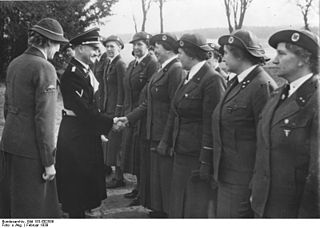
Reichswehr was the official name of the German armed forces during the Weimar Republic and the first years of the Third Reich. After Germany was defeated in World War I, the Imperial German Army was dissolved in order to be reshaped into a peacetime army. From it a provisional Reichswehr was formed in March 1919. Under the terms of the Treaty of Versailles, the rebuilt German Army was subject to severe limitations in size, structure and armament. The official formation of the Reichswehr took place on 1 January 1921 after the limitations had been met. The German armed forces kept the name Reichswehr until Adolf Hitler's 1935 proclamation of the "restoration of military sovereignty", at which point it became part of the new Wehrmacht.
Konteradmiral is a senior naval flag officer rank in several German-speaking countries, equivalent to counter or rear admiral.
Vizeadmiral is a senior naval flag officer rank in several German-speaking countries, equivalent to Vice admiral.
Gefreiter is a German, Swiss and Austrian military rank that has existed since the 16th century. It is usually the second rank or grade to which an enlisted soldier, airman or sailor could be promoted.

The Marinebrigade Ehrhardt, also known as the Ehrhardt Brigade, was a Freikorps unit of the early Weimar Republic. It was formed on 17 February 1919 as the Second Marine Brigade from members of the former Imperial German Navy under the leadership of Hermann Ehrhardt. The Brigade was used primarily in the suppression of the Bavarian Soviet Republic and the First Silesian Uprising, both in the first half of 1919. In March 1920, faced with its imminent disbanding by orders of the government in Berlin, the Marine Brigade was one of the main supporters of the Kapp Putsch that tried to overthrow the Weimar Republic. After the putsch failed and the Brigade was disbanded in May, many of the former members formed the secret Organisation Consul under Ehrhardt's leadership. Before it was banned in 1922, it carried out numerous assassinations and murders in a continuation of the attempts to overthrow the Republic.
Korvettenkapitän is the lowest ranking senior officer in a number of Germanic-speaking navies.
Fregattenkapitän is the middle ranking senior officer in a number of Germanic-speaking navies.
Admiral, short Adm, is the most senior flag officer rank in the German Navy. It is equivalent to general in the German Army or German Air Force. In the Central Medical Services there is no equivalent. In the German Navy Admiral is, as in many navies, a four-star rank with a NATO code of OF-9. The most recent officer of the German Navy to hold the rank is Admiral Joachim Rühle, who serves as Chief of Staff, Supreme Headquarters Allied Powers Europe (SHAPE) in Mons, Belgium since 2020.

In the German military, Waffenfarbe is a visual method that the armed forces use to distinguish between different corps or troop functions in its armed services. The Waffenfarbe itself can take the form of the color of the collar patch, of the piping (embellishment) around the shoulder boards or shoulder marks, or—for enlisted ranks—of the piping around the collar and the garrison cap (Schiffchen).

The Heer as the German army and part of the Wehrmacht inherited its uniforms and rank structure from the Reichsheer of the Weimar Republic (1921–1935). There were few alterations and adjustments made as the army grew from a limited peacetime defense force of 100,000 men to a war-fighting force of several million men.
The rank insignia of the Austro-Hungarian Navy were worn on and on sleeves for navy jackets and coats, or on shoulder straps of shirts and white jackets. Officers' ranks were indicated by lines of 1.3 centimetres (0.51 in) gold braid as were senior non-commissioned officers' ranks, enlisted men's rank was indicated by white stars on their square collar flaps. Senior officers and flag officers would wear a broader gold braid line of 3.3 centimetres (1.3 in) and 5.3 centimetres (2.1 in) resp. beneath smaller lines, in addition flag officers would wear a crown on top of their sleeve insignia.
The Military ranks of Austria are the military insignia used by the Austrian Armed Forces. Austria is a landlocked country and has no navy.
Stabsgefreiter is the second highest rank of enlisted men in the German Bundeswehr, which might be comparable to Corporal (OR-4) in Anglophone armed forces.
Oberstabsgefreiter was the highest enlisted rank in the German Bundeswehr before the new ranks Korporal and Stabskorporal were introduced in October 2021. The rank can be comparable to corporal in Anglophone armed forces.
Soldat is the lowest rank of enlisted men in the land-based armed forces of Germany, Austria and Switzerland. It is usually grouped as OR-1 within the NATO ranking system, excluding the Swiss armed services which is not part of NATO.

Waffenfarbe(n) or Egalisierungsfarbe(n) are colors that communicate the rank and arm of service for members of the police force or the Federal Army of the Republic of Austria (de: Bundesheer der Republik Österreich). They are also referred to as Kragenspiegel (English: collar patches or gorget patches).

Patrouilleführer was a military rank of the k.u.k. Austro-Hungarian Army (1867–1918). It might be comparable to enlisted men OR2/ Private 1st class ranks in Anglophone armed forces.
The military ranks of the German Empire were the ranks used by the military of the German Empire. It inherited the various traditions and military ranks of its constituent states.

The ranks and insignia of the German Red Cross were the paramilitary rank system used by the national Red Cross Society in Germany during World War II.
The Ranks and insignia of German Women's Auxiliary Services were the ranks given to women who served in the German military and paramilitary forces during World War II.





























































